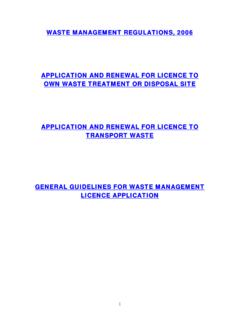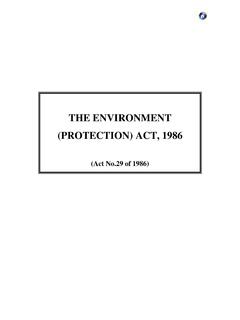Transcription of WATER QUALITY REGULATIONS
1 1 WATER QUALITY REGULATIONS APPLICATION FORM FOR EFFLUENT DISCHARGE LICENCE WATER QUALITY LICENSING GUIDANCE PACK a) Guidelines to Filling in Application Form for Effluent Discharge Licence b) Fourth Schedule Monitoring Guide for Discharge into the Environment c) Eleventh Schedule Fees Chargeable under the WATER QUALITY REGULATIONS d) Facilities listed under the Fourth Schedule 2 REPUBLIC OF KENYA Kenya Gazette supplement No 68 29th September, 2006 (Legislative supplement No. 36) LEGAL NOTICE NO. 120 ENVIRONMENTAL MANAGEMENT AND CO-ORDINATION ( WATER QUALITY ) REGULATIONS , 2006 ARRANGEMENT OF REGULATIONS PART 1: PRELIMINARY REGULATIONS 1 - Citation 2 - Application 3 - Interpretation PART 11.
2 PROTECTION OF SOURCES OF WATER FOR DOMESTIC USE 4 - Prevention of WATER pollution 5 - Standards for Sources of Domestic WATER 6 - Protection of Lakes, Rivers, Streams, Springs, Wells and other WATER sources 7 - Bans, Restrictions, etc, on use of WATER Sources 8 - Compliance with l QUALITY Standards 9 - WATER QUALITY Monitoring PART 111: WATER FOR INDUSTRIAL USE AND EFFLUENT DISCHARGE 10 - WATER for Industrial Use and Compliance with Industrial Standards 11 - Discharge into Aquatic Environment 12 - Discharge into the Environment 13 - Discharge into Public Sewers 14 - Discharge Monitoring 15 - Review of Records 16 - Application for Effluent Discharge License 17 - Effluent Discharge License 18 - License not Transferable PART IV.
3 WATER FOR AGRICULTURAL USE 19 - Use of Wastewater for Irrigation 20 - Abstraction from a WATER Body Under Environmental Management Plan 21 - Creation of Buffer Zone for Irrigation Scheme 22 - Transitional Provision 23 - Compliance with REGULATIONS i 3 PART V: OTHER USES 24 - WATER pollution Prohibition 25 - Recreational Uses PART VI: MISCELLANEOUS PROVISIONS 26 - Inventory of WATER Bodies 27 - Offence 28 - Fees SCHEDULES First Schedule : QUALITY Standards for Sources of Domestic WATER Second Schedule : QUALITY Monitoring for Sources of Domestic WATER Third Schedule : Standards for Effluent Discharge into the Environment Fourth Schedule : Monitoring Guide for Discharge into the Environment Fifth Schedule : Standards for Effluent Discharge into Public Sewers Sixth Schedule : Monitoring for Discharge of Treated Effluent into the Environment Seventh Schedule.
4 Form A Application for Effluent Discharge into Aquatic Environment Form B Effluent Discharge License Form C Register for Effluent Discharge License into the Environment Eighth Schedule : Microbiological QUALITY Guidelines for Wastewater Used in Irrigation Ninth Schedule : Standards for Irrigation WATER Tenth Schedule : QUALITY Standards for Recreational Waters Eleventh Schedule: Fees ii 4 IN EXERCISE of the powers conferred by Section 147 of the Environmental Management and Coordination Act, (1999), the Minister for Environment and Natural Resources in consultation with the relevant lead agencies makes the following REGULATIONS : PART 1: PRELIMINARY Citation 1.
5 These REGULATIONS may be cited as the Environmental Management and Coordination, ( WATER QUALITY ) REGULATIONS 2006. Application of REGULATIONS 2. These REGULATIONS shall apply to drinking WATER , WATER used for industrial purposes, WATER used for agricultural purposes, WATER used for recreational purposes, WATER used for fisheries and wildlife, and WATER used for any other purposes. Interpretation 3. In these REGULATIONS unless the context otherwise requires: Act means the Environmental Management and Co-ordination Act No. 8 of 1999; Authority means the National Environment Management Authority established under section 7 of the Act; , Buffer Zone means distinct or established areas that separate potentially competing users and that serves to lessen the danger of potential conflicts; Environmental Management Plan means the plan referred to under Section 42 (3) of the Act; Designated Representative means any person authorized by the Authority to act on its behalf.
6 Ground WATER means the WATER of underground streams, channels, artesian basins, reservoirs, lakes and other bodies of WATER in the ground, and includes WATER in interstices below the WATER table; Minister means the Minister for the time being responsible for matters relating to the environment. Natural WATER body means any river, stream, spring, lake, swamp, pond, estuary, coastal or other WATER source in a natural WATER course; pH means the negative base 10 logarithm of the hydrogen ion concentration; Point Sources means any discernible, confined and discrete conveyance, including but not limited to any pipe, ditch, channel, conduit, tunnel, well, discrete fissure, container, rolling stock, concentrated animal feeding operation or vessel or other floating craft from which pollutants are or may be discharged.
7 Resource QUALITY in relation to a WATER resource, means the QUALITY of all the aspects of a WATER resource including: (a) the character and condition of the in-stream and riparian habitat; (b) the characteristics, condition and distribution of the aquatic biota; (c) the physical, chemical and biological characteristics of the WATER ; 5 (d) the quantity, pattern, timing, WATER level and assurance of in-stream flow; and (e) the WATER QUALITY stipulated for the reserves. PART II: PROTECTION OF SOURCES OF WATER Prevention of WATER pollution 4. (1) Every person shall refrain from any act which directly or indirectly causes, or may cause immediate or subsequent WATER pollution , and it shall be immaterial whether or not the WATER resource was polluted before the enactment of the Act.
8 (2) No person shall throw or cause to flow into or near a WATER resource any liquid, solid or gaseous substance or deposit any such substance in or near it, as to cause pollution . Standards for Sources of Domestic WATER 5. All sources of WATER for domestic uses shall comply with the standards set out in First Schedule of these REGULATIONS . Protection of Lakes, Rivers, Streams, Springs, Wells and other WATER sources 6. No person shall: (a) discharge, any effluent from sewage treatment works, industry or other point sources into the aquatic environment without a valid effluent discharge license issued in accordance with the provisions of the Act.
9 (b) abstract ground WATER or carry out any activity near any lakes, rivers, streams, springs and wells that is likely to have any adverse impact on the quantity and QUALITY of the WATER , without an Environmental Impact Assessment license issued in accordance with the provisions of the Act; or (c) cultivate or undertake any development activity within a minimum of six meters and a maximum of thirty meters from the highest ever recorded flood level, on either side of a river or stream, and as may be determined by the Authority from time to time.
10 Bans, Restrictions, etc on use of WATER Sources 7. The Authority in consultation with the relevant lead agency may impose bans and restrictions and other measures on the use of sources of WATER for domestic use in order to prevent and control their degradation. Compliance with WATER QUALITY Standards 8. All operators and suppliers of treated WATER , containerized WATER and all WATER vendors shall comply with the relevant QUALITY standards in force as promulgated by the relevant lead agencies. WATER QUALITY Monitoring 9. The Authority in consultation with the relevant lead agency, shall maintain WATER QUALITY monitoring records for sources of domestic WATER at least twice every calendar year and such monitoring records shall be in the prescribed form as set out in the Second Schedule to these REGULATIONS .







![National Water Act [No. 36 of 1998] - Gov](/cache/preview/5/5/3/d/2/3/3/2/thumb-553d233216f6c51422fcd4d6df2eda00.jpg)